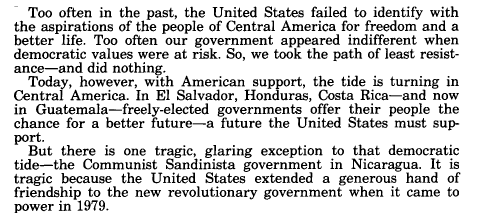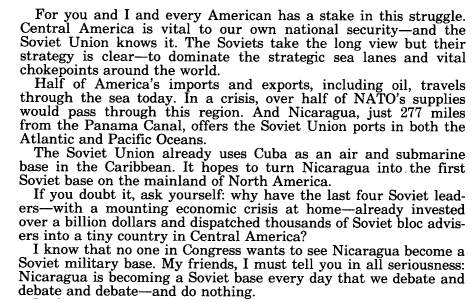This month, HeinOnline continues its Secrets of the Serial Set series by investigating the oft-overlooked Iran-Contra affair, a political scandal involving the Reagan Administration, Nicaraguan civil war, and the Islamic Republic of Iran.
Secrets of the Serial Set is an exciting and informative monthly blog series from HeinOnline dedicated to unveiling the wealth of American history found in the United States Congressional Serial Set. Documents from additional HeinOnline databases have been incorporated to supplement research materials for non-U.S. related events discussed.
The U.S. Congressional Serial Set is considered an essential publication for studying American history. Spanning more than two centuries with more than 17,000 bound volumes, the records in this series include House and Senate documents, House and Senate reports, and much more. The Serial Set began publication in 1817 with the 15th Congress, 1st session. U.S. congressional documents prior to 1817 are published as the American State Papers.
The Serial Set is an ongoing project in HeinOnline, with the goal of adding approximately four million pages each year until the archive is completed. View the current status of HeinOnline’s Serial Set project below.
Two Countries, One Stone
The “Iran-Contra Affair” was a political scandal born out of relations between the United States and two other countries—Iran, in the Middle East, and Nicaragua, in Central America.
The Context in Iran
Throughout the mid-20th century, the United States established itself as one of the foremost arms dealers for the Imperial State of Iran, a Middle Eastern monarchy. Under Shah Mohammad Reza Pahlavi, Iran gradually established its own military industry, and from 1971 to 1975 alone, Pahlavi purchased $8 billion in American weaponry. Congress, unnerved by this substantial purchase, passed the Arms Export Control Act in 1976 to prevent American arms from aiding global terrorism, contributing to an arms race, or encouraging the development of weapons of mass destruction. Even following the act, however, the United States still continued to sell weapons to Iran for the remainder of the decade.

That is, until the 1979 Iranian Revolution. Led by Islamist, leftist, and student organizations, the revolution consisted of a series of events that ultimately overthrew the Pahlavi dynasty, replacing the monarchy with an Islamic republic under Ayatollah Ruhollah Khomeini. Later known as the Iran hostage crisis, one of these events consisted of young Islamists invading the U.S. embassy in Tehran and taking 52 Americans hostage.
Seen as an act of terrorism, the hostage crisis led President Jimmy Carter to impose an arms embargo on the new republic. The revolutionary government had already inherited a wealth of American-made weapons from Pahlavi, but when neighboring Iraq invaded Iran a year later, those weapons weren’t enough. Iran was left desperate for more, but cut off from its primary dealer.

The Context in Nicaragua
Zoom out from Iran and pan westward to Central America—specifically, Nicaragua. Because of its strategic importance, the United States had made several efforts in the early 20th century to protect American interests in the country. In 1912, American influence in Nicaragua became even more entrenched when President Adolfo Diaz, fearing domestic insurrection, asked for the protection of American forces. U.S. Marines were subsequently stationed in Nicaragua from 1912 to 1933, and during that time, the United States helped into power Anastasio Somoza Garcia, the first of a Somoza dynasty that would follow. Read a review of U.S. government operations in Latin America, and particularly, Nicaragua.

The Somoza government was strongly supported by the United States, as was the establishment of its military. However, to maintain power for more than four decades, Somoza and his sons engaged in political corruption, utilizing bribes, siphoning foreign aid, acquiring large portions of land, and more. By the 1970s, when rumblings surfaced of opposing groups such as the Sandinista National Liberation Front (FSLN), the Somoza regime declared a state of siege, and engaged in censorship, intimidation, and torture in response. Due to the apparent human rights violations that were becoming international press, President Jimmy Carter cut off aid to the Somoza regime in 1978.
Thus, at around the same time as Iran’s Islamic Revolution, Nicaragua was also experiencing a chaotic political upheaval. In 1979, the FSLN violently overthrew the third Somoza leader, Anastasio Somoza DeBayle, and established their own revolutionary government. The bloody revolution left Nicaragua devastated, leading President Carter to send $99 million in aid to the country. However, the new Sandinista regime soon showed its own spots, so to speak, declaring that elections were unnecessary and reportedly engaging in several of its own human rights violations, including censorship of the press, domestic espionage, and the repression of indigenous peoples.

The Iran-Contra Affair
With issues such as the Iran hostage crisis dominating the news cycle back in the States, Carter never made it to a second presidential term, and was replaced in 1980 by Ronald Reagan. Upon assuming the presidency in January 1981, Reagan inherited an America still entrenched in a Cold War with the Soviet Union and still fearful of Communism. To the south, anti-Communist Contras and Marxist Sandinistas engaged in bloody conflict. In the Middle East, war raged between two regional powers, Iraq and Iran.
Reagan and Nicaragua
In contrast to his predecessor’s attempts to work with the Sandinista National Liberation Front, Reagan and his administration took on a staunchly anti-communist policy regarding Nicaragua. The potential for Soviet influence in the neighboring region was much too close for comfort, and America had economic interests in Nicaragua that were threatened by the rise of the Sandinista regime. Isolation of the Sandinistas thus became the name of the game, and the opposing Contras were key.


On November 17, 1981, Reagan signed top-secret National Security Directive 17 to authorize $19 million in military aid to anti-Sandinista forces. The intelligence community worked covertly to unify the anti-Sandinista cause while arming and training the Contras to be capable of sophisticated military operations. Democrats in Congress, unhappy that they had been left in the dark, set out to ban all funding for Contra efforts. Unable to gain the required votes to pass such a ban, however, Congress ultimately reached a compromise, passing the first of three “Boland Amendments” in 1982. This first amendment specifically outlawed the appropriation of funds to intelligence agencies for the purpose of assisting the Contras.
Read more about covert operations in Nicaragua and the Boland Amendments.

Reagan and Iran
When Reagan first took office, he initially promised to continue Carter’s arms embargo on Iran. However, just a few months later, senior officials in the Reagan administration came to the conclusion that the embargo was ineffective—Iran was easily finding other ways to buy American arms. The State Department subsequently embarked on a diplomatic quest, known as Operation Staunch, to dissuade other countries from selling American arms to Iran. Some in the Reagan administration feared that this would push Iran into the sphere of the Soviet Union as the country sought assistance.
To make matters more complicated, Iranian-backed terrorists in Hezbollah took several more Americans hostage in 1982, leaving Reagan with the dilemma of securing their release.
A Win-Win Solution
Reagan’s National Security Advisor, Robert McFarlane, devised a solution that, though potentially scandalous, would solve several of America’s problems. Sell Iran the weapons it required and retrieve the American hostages in return, all the while improving U.S. relations in the Middle East and gathering funds that could be directed to aid Contra efforts in Nicaragua. Despite opposition from several administration officials, including Secretary of State George Schultz and Secretary of Defense Caspar Weinberger, Reagan reportedly went ahead with the plan.
By 1986, during Reagan’s second term in office, the U.S. government had sold 1,500 American missiles to Iran for a total of $30 million and the release of three hostages. In November of that year, however, Lebanese magazine Ash-Shiraa publicized the U.S.-Iran weapons-for-hostages deal, causing a media uproar back in the States. Ten days later, Reagan entered the living rooms of all Americans to explain, assuring the public that he does not negotiate with terrorists.


Investigating the Affair
The Scandal Exposed
The arms deal prompted an investigation by U.S. Attorney General Edwin Meese, who soon discovered that $18 million of the $30 million received for the deal was missing. It was at this point that Lieutenant Colonel Oliver North, a primary actor on the U.S. side of the deal, went on a wild shredding spree with his secretary in preparation for questioning. Unfortunately for North, he did not shred one particular document, known later as the “Diversion Memorandum,” that connected the Iran arms deal to the Contra aid. The explosive revelation resulted in Reagan firing North, and led the public to question the President’s role in the matter.

On November 25, 1986, President Reagan announced that he would be gathering a Special Review Board to investigate the affair. The Tower Commission, so-named for commission member Senator John Tower, reviewed “the circumstances surrounding the Iran–Contra matter, other case studies that might reveal strengths and weaknesses in the operation of the National Security Council system under stress, and the manner in which that system has served eight different presidents since its inception in 1947.”
Reagan himself appeared before the commission on its second day, but gave contradictory information—first claiming that he had authorized the arms deal, but later stating that he had no recollection of this. The final report of the Commission ultimately cleared Reagan of knowledge of the deal, but implicated 14 other individuals—some of whom claimed that the President actually knew about and approved the entire operation.

Early in 1987, the House of Representatives and the Senate formed their own committees to investigate the scandal. In their joint Majority Report, the two houses concluded once again that it was unclear the extent to which Reagan was involved, but that the administration overall exhibited “secrecy, deception and disdain for the law.” Select administration officials testified that they were responsible for the affair and that they withheld key facts from the President. Peruse biographical profiles of all individuals involved in the Iran-Contra affair and then read the testimonies of some of the key figures below:
- Lieutenant Colonel Oliver North
- National Security Adviser Robert McFarlane
- Deputy National Security Adviser John M. Poindexter
- Secretary of State George Shultz
- U.S. Attorney General Edwin Meese
In the end, Reagan was never charged and left office as a relatively popular president, and the Iran-Contra Affair has been relegated to a seldom read chapter in American history.
Help Us Complete the Project
If your library holds all or part of the Serial Set, and you are willing to assist us, please contact Shannon Hein at 716-882-2600 or shein@wshein.com. HeinOnline would like to give special thanks to the following libraries for their generous contributions which have resulted in the steady growth of HeinOnline’s U.S. Congressional Serial Set.
- Wayne State University
- University of Utah
- UC Hastings
- University of Montana
- Law Library of Louisiana
- George Washington University
- University of Delaware
We will continue to need help from the library community to complete this project. Download this Excel file to see what we’re still missing.
Never miss a post!
Subscribe today to receive our Secrets of the Serial Set right to your inbox.



